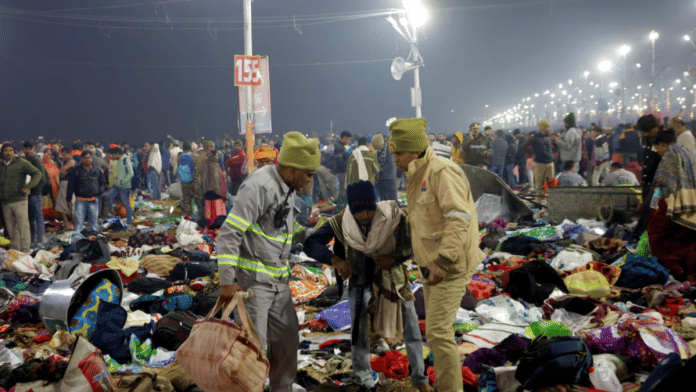Nothing tests crowd management quite like faith. Especially when, spread over just six weeks, 40 crore people are expected to descend on a city. At the Maha Kumbh in Prayagraj, faith led to chaos, and crowd management went for a toss.
At least 30 people were killed and more than 60 injured in a pre-dawn stampede on Mauni Amavasya, the biggest bathing day of the mela, held on 29 January. The administration took nearly 16 hours to hold its first official briefing and release the death toll.
Just some 10 days earlier, Uttar Pradesh Chief Minister Yogi Adityanath had declared that the government wasn’t relying on any “hypothesis” but on “scientific analysis of daily headcounts in the mela area” to manage the crowd.
Yet, the stampede shows that the safeguards in place were far from perfect. Stampedes at festivals, religious gatherings, political rallies, and even railway stations follow the same deadly pattern—overcrowding, panic, and failure to control a surge of people. India, a country of 1.4 billion, can’t afford to keep getting this wrong. And that’s why the science of crowd management is ThePrint’s Newsmaker of the Week.
Also Read: I saw a Maha Kumbh stampede in the making during the first Shahi Snan
The stampede
In the aftermath of the tragedy, Uttar Pradesh CM Yogi Adityanath, fumbling and sobbing on camera, promised an investigation. Five special officers were immediately deployed.
This came despite weeks of government assurances that the ‘Digital Kumbh’—equipped with AI-based monitoring systems and drones—would ensure smooth crowd control in sync with manpower.
Videos from the scene showed waves of pilgrims trampling over devotees resting near the Sangam. Some jumped over columns, while others clung to their families as they jostled for space.
Some who were present at the site reported a sudden rush toward the river, causing people to fall over each other. Others said blocked paths to the water trapped the crowd, leading to suffocation and people falling.
The administration, however, blamed the unruly crowd, saying they broke through barricades.
Thirty people are confirmed dead by the administration but reports citing unnamed official sources claim the death toll is closer to 50.
Science of crowd management & ‘VIP culture’
Crowd science is about predicting movement, controlling the flow of people, and stopping panic before it turns deadly.
Former Uttar Pradesh DGP Om Prakash Singh told ThePrint effective crowd dispersal is central to crowd management.
“Crowd dispersal is crucial. The idea is to drive out people immediately from the area. Keeping the crowd stagnant is the recipe for mismanagement. It makes the people restive,” said Singh, who has overseen Kumbh crowd management as an SP in 1989, SSP in 1995, and as DGP in 2019.
On Wednesday, 10 crore devotees took the ritual bath, which presented a formidable challenge for the administration. Yet, despite repeated calls for crowd dispersal via megaphones, the administration failed to take the necessary steps to make it happen.
As reported by ThePrint, many of the 30 pontoon bridges installed to facilitate the movement of devotees were closed for three days and roads were diverted in several areas due to VIP arrivals, creating a bottleneck.
Two days before the Mahakumbh, CM Adityanath held a press conference, lauding the government’s AI-driven crowd management and claiming that “previous governments caused stampedes”. Hoardings featuring Prime Minister Narendra Modi and Adityanath were plastered across Uttar Pradesh, inviting people to witness the dawn of a new Kumbh era.
Ahead of the Mauni Amavasya bath, the administration declared the Mahakumbh a no-vehicle, no-VIP zone. But opposition leaders, including Rahul Gandhi, accused the government of prioritising “VIP culture” over public safety.
Videos surfaced online showing Yogi Adityanath playing in the Sangam waters after taking the dip, as well as of Home Minister Amit Shah having his grandson blessed by sadhus. Photos of celebrities like Milind Soman and Remo D’Souza posing at Kumbh have also been doing the rounds. Social media backlash against VIP culture has followed.
“Why the privileged treatment for the rich and powerful?” one X user posted, sharing a video of luxury tents. Another questioned how, if Hindus were one, there was “a separate system for VIPs and the aam aadmi (common people).”
Former Uttar Pradesh DGP Vikram Singh also told ThePrint that VIPs should avoid Maha Kumbh as their presence disrupts security arrangements.
“Their presence puts pressure on the police and cripples the system,” he said.
Also Read: Inside Elite Kumbh—no crowds, no chaos, only VIP Sangam, 5-star spirituality
Stampede in the making
Crowd disasters are “scientifically well understood, easy to predict, and inexpensive to prevent,” Tracy Hresko Pearl, a leading scholar in the field of technology and the law, wrote recently in The Hindu.
In the Kumbh, there were early signs of vulnerability. The first warning came during the first Shahi Snan on 14 January, when a wave of of devotees rushed into the Sangam waters in the morning from a spot reserved for sadhus. As they overtook the designated area, chaos erupted. The police made frantic calls to control the situation.
The commotion lasted for about 20 minutes but it was a forewarning. I’ve written about my experience that day and how I too fell and injured myself in the melee. On Mauni Amawasya bath, the crowd was double compared to 14 January.
Meanwhile, several kilometres away, an elite Kumbh was unfolding undisturbed. With VIP ghats, luxury tents, palm-lined river-view boulevards, far away from the misery and mayhem.
With another four Shahi Snans left, the administration faces a formidable challenge ahead.
Views are personal.
(Edited by Asavari Singh)







Ms. Kissu, the clairvoyant, is back in action.
The Yogi government made a mistake. Should have included her in the Mela management committee.